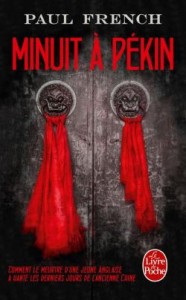Posted: June 16th, 2015 | No Comments »
Today, June 16th is Bloomsday! If you’re not a James Joyce aficionado June 16 is the day all of the events in Joyce’s Ulysses take place. It also happens that, of late, there have been rather a lot of stories regarding the supposed popularity of Ulysses and Finnegans Wake in China (such as here). And so a little Joycean-related tale from old Shanghai…one author who may actually be having an easier time getting published in Communist China than he did in Republican China…
In September 1940 the Shanghai Municipal Police (SMP) took upon itself the task (and considering Shanghai was surrounded by the Japanese army and the war drums were beating loud one wonders if they didn’t have anything better to do!) of launching a concerted campaign to ensure that no English language books deemed ‘unfit for public sale’ (or “salaciousâ€) should be available in the territory of the International Settlement. The campaign began by seizing several copies of various D.H. Lawrence and Joyce novels available in both foreign and locally operated bookstores.
Events began on September 5th 1940 when the Chinese-owned and managed Modern Book Company’s branch at 357 Szechuan Road (now Sichuan Middle Road) was visited by officers of the SMP. A number of English language books were confiscated and delivered to Detective Superintendent (DSI) S.A. Young at Shanghai Special Branch. Titles confiscated included D.H. Lawrence’s Lady Chatterley’s Lover, Alexander Kuprin’s Yama: the Pit (concerning prostitution in Russia), James Joyce’s Ulysses, Theodoor van der Velde’s Ideal Marriage: Its Physiology and Technique and a book entitled Sex Life in France. These seizures were followed by confiscations of Lawrence’s Women in Love, The Rainbow, The Woman who Rode Away, Aaron’s Rod, The White Peacock, Sons & Lovers, Lovely Lady, The Ladybird and The Lost Girl as well as a collection of Lawrence stories, A Modern Lover. There were also several books not by Lawrence confiscated including Ely Culbertson’s The Strange Lives of One Man, a rather racy, for the time, memoir by a contact bridge player and rampant self-publicist. Additionally, a number of non-fiction titles were also seized including Theodoor van der Velde’s Sex Hostility in Marriage: Its Origin, Prevention and Treatment and Sex Techniques in Marriage, as well as Victor Robinson’s Encyclopaedia Sexualis and, finally, a book entitled The Power to Love. All of these books were essentially early sex manuals.
Eventually all of these titles were deemed “OK†by the SMP Translation Office with the exception of Lawrence’s Lady Chatterley, Kuprin’s Yama: the Pit and Joyce’s Ulysses. And so the police moved to other bookshops in the Settlement and proceeded to seek out copies of Lawrence, Kuprin and Joyce. By the end of 1940 Lawrence, Kuprin and Joyce were not to be found on the shelves of the International Settlement’s bookshops.
Of course Ulysses had long suffered censorship and banning in the UK and USA. However, a couple of things to note that make this 1940 SMP campaign against Joyce in Shanghai interesting:
1) Technically the SMP could censor whatever it felt it appropriate under the prevailing political situation in the International Settlement. However, in general terms, it seems they followed the censorship trends pertaining in Great Britain at that time. However, by confiscating and seizing for destruction copies of Joyce’s Ulysses they were extending their writ, as England had already rescinded its ban on Joyce’s novel four years earlier in 1936.
2) A number of copies of Ulysses seized by the SMP in Shanghai were returned to a book wholesaler in Tientsin (Tianjin) that supplied English language books throughout China. The copies returned to Tientsin were then reportedly placed back on sale in that treaty port which had its own, separate, censorship regime, municipal police system and local government organisations who never bothered to launch a crackdown.
Effectively with the crackdown in 1940 the SMP appears to have been making judgements independently of those being taken both in other countries and in other China treaty ports. They didn’t like Ulysses and so it was banned…
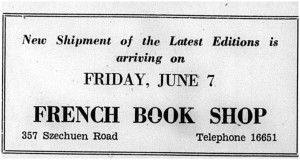
The French Book Store was run by a Mr. Bonardel, a French national. The bookstore sold French and English language titles as well as materials in some other European languages. The shop shared premises with the Modern Book Company at 357 Szechuan Road.
Posted: June 15th, 2015 | No Comments »
So we all know who Shanghai Lil was – many a song about her. But who was “Peiping Lil”, sometimes referred to as “Peking Lil” though as she operated after 1927 was technically in Peiping. She is described in the scant articles about her as “Lily Lee”, a “beautiful Chinese Mata-Hari”, a glamorous dance-hall hostess in Peking who doubled as a super-spy. After the Japanese invasion she apparently used her beauty and access to inveigle secrets out of senior army officials. However, the stories are all a bit incomplete – Japanese or Chinese secrets? In 1938 she was arrested and taken to Chungking, the then Nationalist capital. However, she was released on bail and transported to Hong Kong after her trial on espionage charges in December 1938. It is claimed she had been arrested on spying charges many times and it had been rumoured that she had been executed. The questions are too many?
Who was she really?
Who did she spy for?
If she betrayed the Nationalists why did they let her leave after her trial for Hong Kong?
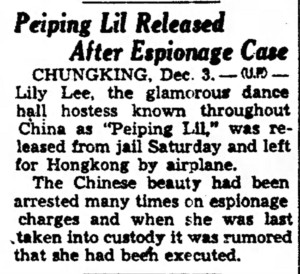
Posted: June 15th, 2015 | No Comments »
Demon pilots in the China skies….

The ace pilots of the Republic of China Air Force have long been shrouded in mystery and obscurity, as their retreat to Taiwan in 1949 and a blanket martial law made records of the RoCAF all but impossible to access. Now, for the first time, the colourful story of these aces can finally be told. Using the latest research based on released archival information and full-color illustrations, this book charts the history of the top scoring pilots of the RoCAF from the beginning of the grueling, eight-year Sino-Japanese War to the conclusion of the Civil War against the Chinese Communists. Beginning as a ragged and very disparate group of planes and pilots drawn from various provincial air forces, the RoCAF gradually became standardized and was brought under American tutelage. Altogether it produced 17 aces who scored kills whilst flying a startling variety of aircraft, from biplanes to F-86 Sabres.
Posted: June 14th, 2015 | No Comments »
Every time Shanghai does a population census the numbers get more ridiculous and argued over – 18, 19, 23 million or whatever. In 1936 the city topped out at a then impressive 3,500,000 having added 135,000 odd over the last year. Of course the next year, 1937, the influx would be significantly more as refugees from Japanese attack flooded into the city. Still, in 1936, Shanghai came in fifth globally and looked likely to have more people than Berlin pretty soon. It’s been a while since Shanghai and Berlin competed on the population numbers stakes!!

Posted: June 13th, 2015 | No Comments »
By January 1938 the Chinese nationalist soldiers that had been fighting the Japanese around Shanghai were in retreat. Here, in January 1938, a Chinese soldier attempting to enter the French Concession is disarmed by a French soldier before being admitted…..

Posted: June 12th, 2015 | No Comments »
Hsiao-yen Peng’s Dandyism and Transcultural Modernity doesn’t have the most exciting of covers so I’ve improvised…still looks a fascinating read…
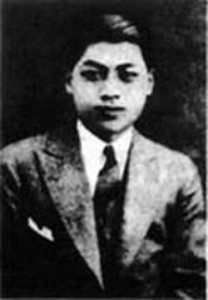
Liu Na’ou – Chinese Dandy
This book views the Neo-Sensation mode of writing as a traveling genre, or style, that originated in France, moved on to Japan, and then to China. The author contends that modernity is possible only on “the transcultural site”―transcultural in the sense of breaking the divide between past and present, elite and popular, national and regional, male and female, literary and non-literary, inside and outside. To illustrate the concept of transcultural modernity, three icons are highlighted on the transcultural site: the dandy, the flaneur, and the translator. Mere flaneurs and flaneurses simply float with the tide of heterogeneous information on the transcultural site, whereas the dandy/flaneur and the cultural translator, propellers of modernity, manage to bring about transformative creation. Their performance marks the essence of transcultural modernity: the self-consciousness of working on the threshold, always testing the limits of boundaries and tempted to go beyond them. To develop the concept of dandyism―the quintessence of transcultural modernity―the Neo-Sensation gender triad formed by the dandy, the modern girl, and the modern boy is laid out. Writers discussed include Liu Na’ou, a Shanghai dandy par excellence from Taiwan, Paul Morand, who looked upon Coco Chanel the female dandy as his perfect other self, and Yokomitsu Riichi, who developed the theory of Neo-Sensation from Kant’s the-thing-in-itself.
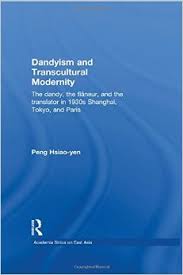
Posted: June 11th, 2015 | No Comments »
Nancy Chen was a star of Shanghai’s wartime cinema. She was referred to in the foreign media as China’s “Oomph Girl” and was seen as a symbol of westernisation and the liberated woman on screen. She was a star when the pre-war generation, such as Butterfly Wu, had largely retired, or semi-retired, or refused to work during the Japanese occupation. These pictures are from a profile of her in the American newspapers that chose to note the following:
She is a little over five feet tall
She is unmarried
She likes to wear tennis shoes and plays badminton on the roof of her apartment building
She enjoys serving hors d’oeuvres to guests in her modern apartment in the French Concession
She drives a blue roadster
She loves to swim….
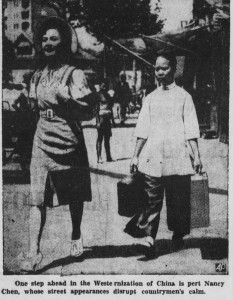
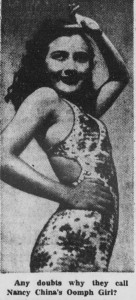
Posted: June 10th, 2015 | No Comments »
A new small edition of Midnight in Peking is out in France – Minuit a Pekin – from Le Livre de Poche for only 7 euros 60 – looks lovely. It’s a Prix des Lecteur – which is apparently, ‘Décerne annuellement le prix des lecteurs à un romancier choisi par 170 jurés amateurs. Deux sélections existent : littérature et polar.’
More details here
